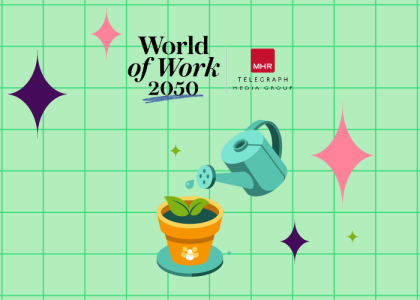Why workplace learning is essential

Investing in learning and encouraging a growth mindset empowers employees, but it can also be a key driver of high performance for an organisation.
Why should organisations invest in learning?
Employers that want to retain and nurture high performers need to cater to their desire to grow from the moment they join the organisation, whether that’s by:
- Offering training courses
- Providing upskilling opportunities
- Introducing a mentoring programme
- Investing in a digital learning platform
Nowadays, learning and development shouldn’t just be an added benefit; it must be embedded in your organisation’s culture and accessible for all employees. Forward-thinking leaders should be developing clear learning strategies, identifying existing skills in their business, mapping out opportunities for development, and investing in technology that supports every employee’s learning.
In situations of economic uncertainty, organisations are under more financial pressure and often this leads to L&D budgets being cut. This approach is more likely to have negative effects in the long run though, causing low morale, reduced productivity, and high turnover.
Rather than neglecting workplace learning strategies in periods of mass resignation and economic instability, prioritising learning and upskilling is emerging as the counter measure. A study by McKinsey & Company showed the main reason employees said they would leave their job is a lack of career development, so it's crucial for organisations to prioritise employee learning and growth. By investing in people and training them with necessary skills, employers can drive high performance and retain the people that make the organisation successful in the long term.
Longstanding MHR customer the University of Chichester is an organisation that has built a lifelong learning culture across its workforce and has been better able to attract and retain talent because of this. Their HR and Professional Development Manager Kevin Botto comments, “For us as an employer, it's important that we have people who continually want to learn. And I think it makes things more interesting for the individual and attracts them to the organisation.”
Building a growth mindset
To build a learning culture in an organisation, you need to encourage employees to cultivate a growth mindset, a term coined by psychologist Carol Dweck in the 1970s. After studying the attitudes and behaviours of thousands of children, she noticed that some of her students seemed to rebound from failure, while others seemed to be more affected by small setbacks.
In her book Mindset: The New Psychology of Success, Dweck wrote that people with a fixed mindset have the “belief that an individual’s basic abilities and skills, their intelligence and their talents, are just fixed traits”, while those with a growth mindset believe that “an individual’s most basic abilities and skills can be developed through fixed dedication and hard work”.
On an individual level, having a growth mindset builds resilience and an openness to adapt in the face of challenges. Employees with growth mindsets will view their mistakes as opportunities to learn rather than outright failure. According to Amy Edmondson, Professor of Leadership and Management at Harvard Business School, “When people understand that their value comes from their ability to learn, not from their current ‘stock of knowledge’ they are better able to [work as a] team, experiment thoughtfully and learn effectively”.
Driving high performance with a growth mindset
Dweck also found that having a growth mindset was important for organisational success. In one study, she saw that employees in a fixed mindset company were more anxious about failure, leading to an influx of cheating, secrecy and corner cutting. On the other hand, employees in a growth mindset company were more positive, collaborative and innovative. This is echoed in MHR’s latest research, too. We found that a culture of learning and growth is one of the main drivers of high performance in any organisation.
It's easy to see the benefit of cultivating a growth mindset, but how do you actually embed this at an organisational level? Botto says a learning culture must “come from the very top. It can’t be certain individuals or managers believing that learning is important – it has to be embedded throughout.” Essentially, when business leaders set the example, employees will be more likely to follow suit.
Learning across the generations
When improving your learning and development strategy, it’s important to consider that different generations tend to have different approaches to learning. As digital natives, Generation Z employees have more of an appetite for digital learning content and learning experience platforms (LXPs) that allow them to take charge of their own learning. By investing in a learning platform, you’ll meet this generation’s expectation and support them in their development.
Learning and development shouldn’t just be focused on the younger generation, though. Building a culture of learning throughout your organisation also means supporting employees from older generations, too. Yes, they have plenty of knowledge and experience in their field, but there are also new technologies and skills in demand that they may need training on. As put by Rob Warwick, Professor of Management and Organisational Learning at the University of Chichester, “The idea that we don’t have lifelong learning, that learning finishes at 18, is mad.”
Employees from different age groups can also learn from each other. Mentoring and reverse mentoring programmes allow employees from across the generations to benefit from their diversity of skills and experiences, coming together to share knowledge or skills.
“I’ve seen young people come in with a completely fresh outlook and a different way of doing things,” Botto says, which can provide a balance to more established viewpoints. “The dynamic between those two groups is really good; you’ve got someone coming in with new ways of thinking, but they’ve got the older generation who might have gone through it already and have the organisational context.”
The future of learning technology
As the world of work continues to reinvent itself, businesses must be prepared to adapt. If leaders want to retain the best talent and improve employee experience, they need to develop a culture of learning that goes beyond traditional training programmes and invest in digital learning, too, in tune with the needs of the modern workforce.
People First Learning allows organisations to embed a lifelong learning culture in the workplace and empowers employees to take their development into their own hands. The platform simplifies and automates essential training, supports everyday bite-sized learning, and helps to develop skills that matter across the workforce. Managers can build catalogues of courses and create customised pathways tailored to individual employees, ensuring that everyone – from graduates and apprentices to senior leaders –gets a positive learning experience.
This is a shortened version of an article produced by and published on Telegraph.co.uk – read the full article here.
Level up your learning
Register now for our World of Work 2050 webinar series and you’ll get on-demand access to all 12 episodes as they’re released on the last Thursday of every month.
In the latest webinar, MHR and Docebo explore technology’s role in the future of learning from both a UK and Northern American perspective. Sign up to find out how AI is changing the way we learn and how it can allow employees to personalise their own development.



